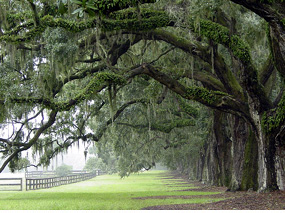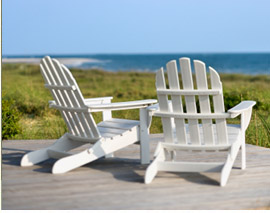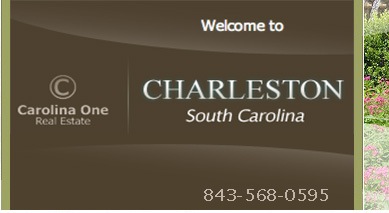| |
    
 |
| |
 |
What's Going on in Charleston, SC
Summer offers some of Charleston's most famous sights and sounds, as
the city comes alive with Carolina Day celebrations and fireworks
displays.
Carolina Day is June
28th in Charleston, and a very special celebration commemorating the
Revolutionary War victory over the British at Sullivan’s Island, 235 years ago
in 1776. Each Carolina Day is observed with a parade down Meeting Street from
City Hall at noon, culminating with festivities at the Gen. William Moultrie
monument on White Point Garden. Carolina Day is a perfect patriotic kick-off for
Fourth of July celebrations exactly one week later, and ringing the historic
harbor where Americans battled the British are a series of explosive fireworks
displays in a dramatically scenic setting.
|
 |
Featured Charleston Properties
To view more Charleston area listings, please visit Charleston Real Estate |
 |
What's Going on in Charleston, SC
The South Carolina
Aquarium offers its family-friendly 4th celebration, with food, music, and
4-D theater presentations overlooking the Cooper River, culminating with the
Patriots Point fireworks around 9:15 pm. Tickets are $60 for adults and $30 for
children (under 2 years old free), and include beer, refreshments and food. For
more information, call 843-577-FISH. Fireworks shows commence
shortly after dark at Patriots Point and Sullivan’s Island, and can be enjoyed
free from Waterfront Park and the High Battery.
Fish competitively for saltwater species from the second largest pier on the
East Coast at the Folly Pier Fishing Tournament, July 23rd, and August 20th. The
beautiful pier on Folly Beach is fully equipped with anglers stations,
restrooms, pavilion and refreshments for a magnificent view of the Atlantic surf
and its various game fish. King Mackerel, Channel Bass and Ladyfish are among
the prize categories for largest catch on tournament days, and offer some
exciting action at one of Charleston’s most family-friendly locations.
Registration is on-site beginning at 6am on tournament days, and prizes are
awarded at 4:15pm. Adult fee is $12, children 3-12 $7, and adult chaperone is
required for participants 15 and under. For more information call 843-588-3474
or online at www.follyfishingpier.com.
For Summer sounds under the
oaks, nothing compares with the free Live Music Series at Freshfields Village,
every Friday during June and July from 6-9pm. Beach music, R&B, Motown, jazz, acoustic and
pop rock are all featured sounds by live bands playing in the outdoor setting on
historic Johns Island, between Kiawah and Seabrook Islands. Beer, wine, sodas
and food are available for purchase, but the concerts are free, and add a lively
musical flavor to an area historically used for growing fresh summer crops. For
more information, visit
www.freshfieldsvillage.com.
during June and July from 6-9pm. Beach music, R&B, Motown, jazz, acoustic and
pop rock are all featured sounds by live bands playing in the outdoor setting on
historic Johns Island, between Kiawah and Seabrook Islands. Beer, wine, sodas
and food are available for purchase, but the concerts are free, and add a lively
musical flavor to an area historically used for growing fresh summer crops. For
more information, visit
www.freshfieldsvillage.com.
The boys of summer play
baseball along the Ashley River in the cozy confines of beautiful Joseph P.
Riley, Jr. Park. “The Joe” is designed for families to enjoy America’s favorite
pastime in a pleasurable setting featuring a picnic area, shopping concourse and
comfortable seats in a scenic setting. The home team, the Charleston Riverdogs,
is part of the New York Yankees minor league system, and many former players are
in the major leagues today. The summer season is loaded with entertaining events
– all Friday night games end with a fireworks display, and fans are invited to
participate in themes such as sack races, face-painting and hot dog eating
contests between innings. It’s a great time in a beckoning venue. For ticket
information and scheduled games and events, call 843-577-3647 or go online at
www.riverdogs.com.
|
 |
Charleston Indoors -
Exhibits
Paintings: A Soldiers View of
the Civil War on loan from Richmond, VA museum until July 10th. As a Confederate
soldier under the charge of General P.G.T. Beauregard, Chapman created his
remarkable paintings of the forts and batteries in and around Charleston Harbor.
Civil War, CW 150 and Sesquicentennial.
www.gibbesmuseum.org
For history students
and enthusiasts visiting Charleston for a summer vacation, don’t miss “City
Under Siege: Charleston in the Civil War”, exhibited at the Charleston Museum at
360 Meeting Street. This permanent exhibit displays weapons, uniforms,
cannonballs, artifacts, period pictures, diaries and other first-hand aspects of
Charleston’s important role in the Civil War from 1860-65. For museum
information call 843-722-2996 or online at
www.charlestonmuseum.org .
There’s also the
multi-location museum exhibit “Secessionists, Soldiers and Slaves”, featuring
the Edmondston-Alston house at 21 East Battery, where Charleston’s Confederate
commander, Gen. P.G.T. Beauregard observed the firing on Fort Sumeter, and
Middleton Place Plantation on Ashley River Road, where the saga of the Civil War
homefront is portrayed in artifacts detailing the lives of slaves and slave
owners. Information for both exhibits can be found online at
www.middletonplace.org. |
Charleston Explorer -
Charleston Windows
Windows in Charleston are notable on some
historic buildings for their rippled, wavy texture. This is evident in many of
the windows at St. Michael’s Church, and well-explained by the look of one
facing Broad Street on the north side of the building. On that second window
from the Meeting Street front, there is a curious-looking pane displaying raised
rings encircling a small, glass-filled hole. This is a “bulls-eye”, the part of
a molten mass glass attached to a pole and spun so that centrifugal force would
spread the glass into thin sheets for window panes. This spinning method was
widely used until the 1830’s, and it was the motion of the spinning mass that
caused the familiar ripples in the old glass.
Inside St. Michael’s, there are four famous stained glass windows. Created
between 1893 and 1915, the four include three made by the Tiffany and Company of
New York. The centerpiece window, overlooking the chancel, is a spectacular
image of St. Michael symbolically casting out the dragon image of the devil from
heaven. Just to the left of the chancel, also on the east wall of the church, is
a Tiffany window displaying a scene of Christ’s followers gathered on Easter
morning, while on the north side is the third Tiffany displaying a scene of the
Annunciation. The fourth stained glass on the south side is attractive, but is
markedly less vibrant in color than the Tiffany windows, which show less leaded
inserts and a truly some of the best sights in Charleston – especially
considering that St. Michael’s is open to the public six days a week! |
 |
Charleston
Architecture -
Houses in Charleston’s historic
district often feature distinctive exterior elaborations such as quoins,
earthquake plates, belt courses, fire marks, splayed lintels, chimney corbels,
fanlight doorways with triangular pediments, and attached columns and pilasters.
Most of these are purely architectural enhancements that show off the skill of
various historic eras, as well as the wealth of those who owned the houses.
Quoins, the raised exterior surface along the edge of a building, are typically
protruding bricks covered by plaster, and get their name from the French word
for “corner”. The first house in Charleston built with such decorative quoins is
the Col. Robert Brewton house at 71 Church Street, constructed circa 1720. Belt
courses are typically similar raised brick surfaces covered with plaster,
extending horizontally between floors, but splayed lintels, those wedge-shaped
additions above windows, are often made of granite or marble, such as those at
the 1811 Nathaniel Russell house at 51 Meeting Street. Chimney corbels are again
a protruding brick, created at the top edges of chimneys as a decorative touch.
It took considerable bricklayer artistry to affect those at the top of the 1790
County Court House, as each brick course reaches farther outward as the top of
the chimney rises. Exterior woodwork was increasingly more elaborate after the
Revolution, and a popular effect was to make the entrance door look like a
house. Flanking columns (rounded) or pilasters (flat) were topped by a
triangular pediment and fanlight window, a good example added on the 1735 Thomas
Rose house at 59 Church Street. Earthquake plates and fire marks were originally
meant for utility, but later became a style. The plates were attached to iron
rods run between flooring as a bracing mechanism after Charleston’s earthquake
in 1886, but have evolved as an ornamentation, such as the lion’s heads covering
plates on the 1838 William Roper house at 9 East Battery. Fire marks were
originally the designation that a house was protected by a certain private fire
company, but after the city department was created in 1881, they became
keepsakes, and one of the most colorful is displayed on the 1911 Victorian house
at 13 Water Street.
|
 |
Bet
You Did Not Know -
South Carolina is today called
the Palmetto State, but that wasn’t always the case. Old vehicle license plates
still exist from the early 1930’s, when a motto beneath the name South Carolina
read “The Iodine State” or “The Iodine Products State”. At that time, South
Carolina was promoting its farm products as sources of healthy levels of iodine,
but after iodized salt was introduced, the fad faded and South Carolina became
the Palmetto State.
South Carolina’s state tree, the Sabal Palmetto, is also the state tree of
Florida, which fortunately took the motto “Sunshine State.” The Palmetto has
historically been a military symbol in South Carolina, dating to the famous
battle of Sullivan’s Island on June 28, 1776. In that battle against the British
at the outset of the Revolutionary War, the palmetto tree came in handy as a
defensive bulwark against English cannonballs. South Carolina soldiers defended
Charleston’s harbor entrance from the attacking British by building a fort on
Sullivan’s Island, firing guns from behind palmetto logs packed with sand. The
palmetto, which has a spongy core instead of bark, absorbed British cannonballs
and smothered their fuses without exploding, winning the battle for the
defenders.
Palmetto flags were used by South Carolina troops in succeeding years, and it
was such a banner that was raised over Chapultepec by U.S. troops during the
Mexican War. In honor of the tree’s significant role in South Carolina’s
independence, it was added to the first official state flag, adopted in January
of 1861. Today the Order of the Palmetto is among the state’s most prestigious
awards for its distinguished citizens, and the name Palmetto State is South
Carolina’s to keep.
|
 |
Charleston
Market Report -
CHARLESTON, SC—(June 10, 2011)
According to preliminary data released by the Charleston Trident Association of
REALTORS® (CTAR) 804 homes sold at a median price of $179,945 in May, which
reflects 8% less buying activity and a 4% reduction in median price when
compared to May 2010, when 878 homes sold at a median price of $186,497, as
buyers were responding to the appeal of the homebuyer tax credit.
Sales volume grew by 4% and median price increased by 3% from April to May.
"We anticipate declines in year-over-year sales volume through the third quarter
of this year. The data we’re analyzing thus far in 2011 reflects activity in a
non-incentivized market, so it’s difficult to draw meaningful comparisons over
last year’s figures” said 2011 CTAR President Rob Woodul. |
|
|
|
 | |
| |
|


